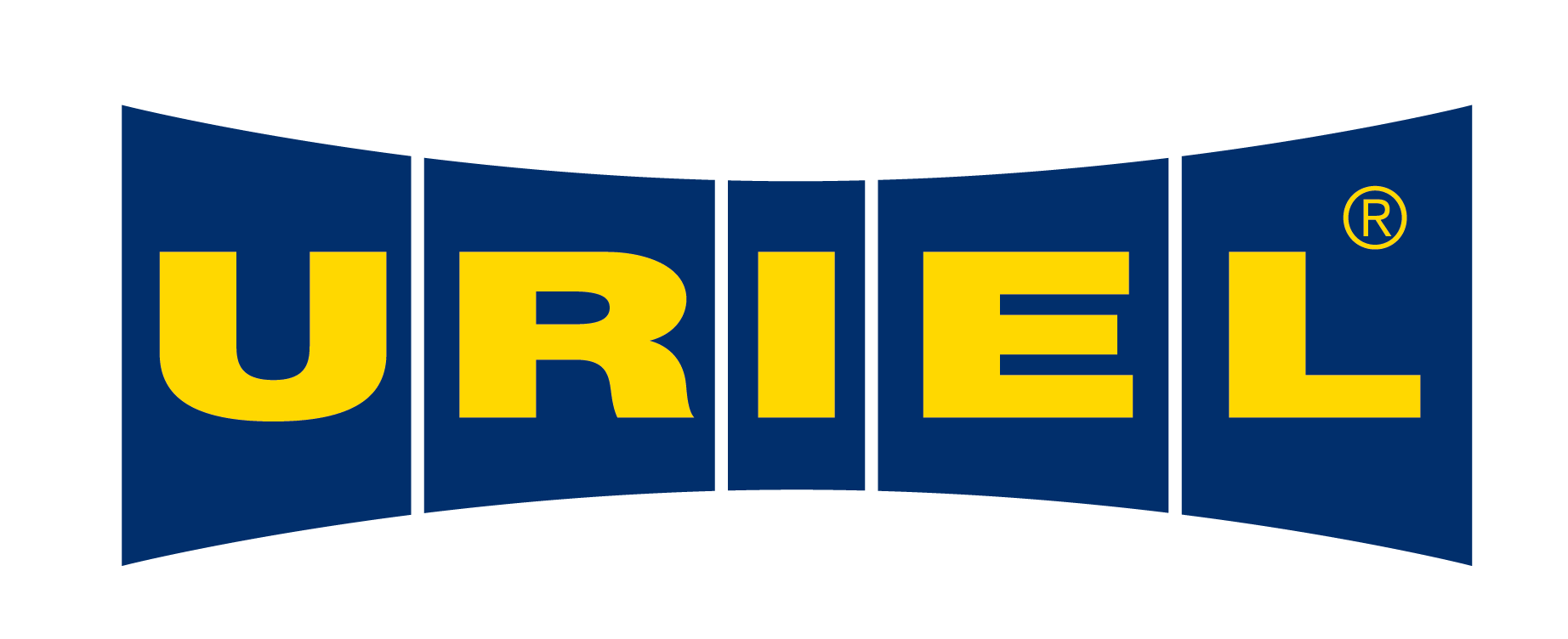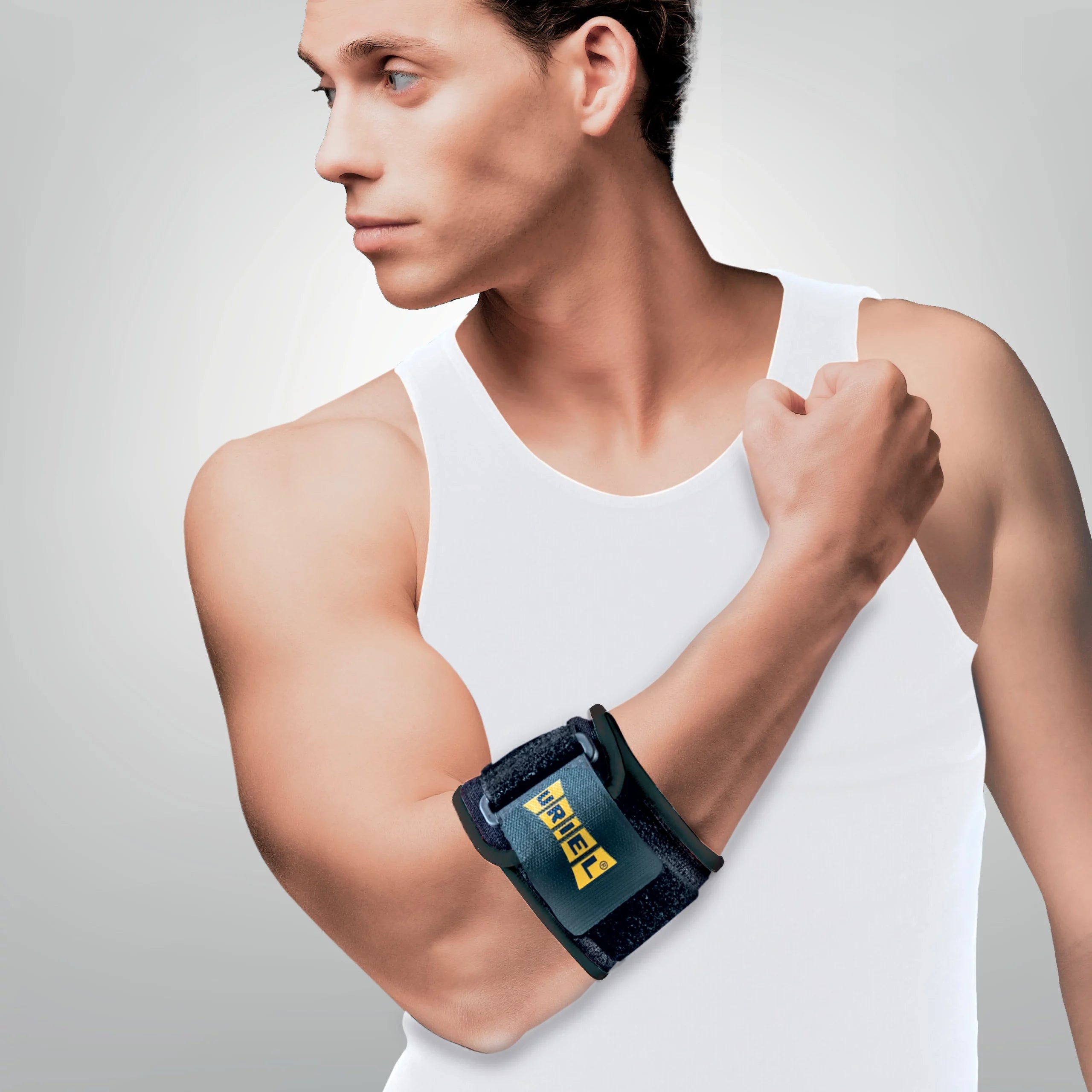
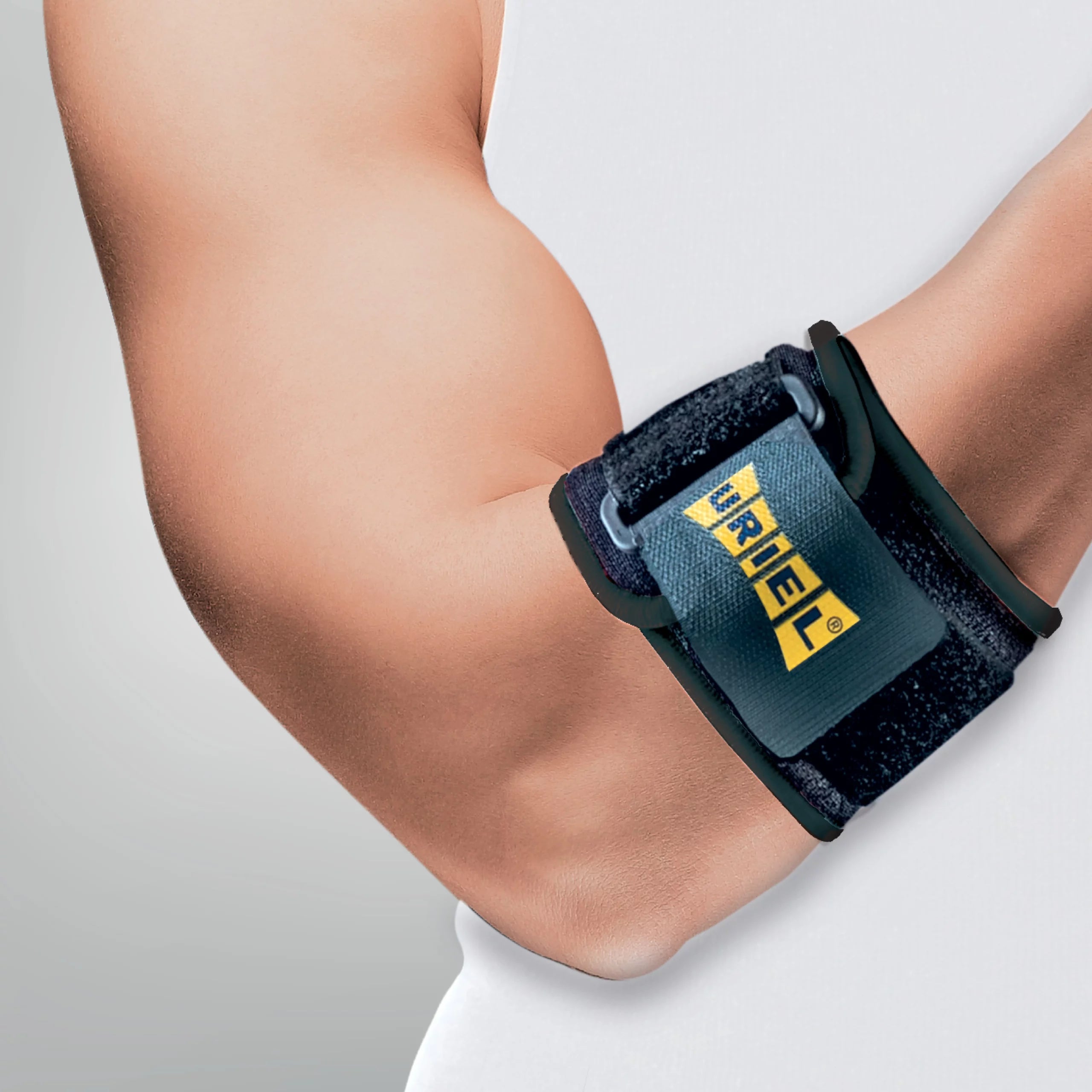

Tennis Elbow Brace | AC91
Tennis elbow brace combined with silicone pad
A brace with a Velcro strap to tighten the forearm muscles to the desired intensity. Made of flexible neoprene combined with breathable fabric that provides elasticity to relieve pressure on the painful area. Contains a silicone pad covered in sweat-absorbing fabric. Suitable for the right or left hand.
Medical indications:
- Tennis Elbow
- Golfer's Elbow
- Epicondylitis

Dimensions

Extended description
Planning and design:
Elbow tendonitis is often caused by repetitive movements that cause overload. The elbow brace creates pressure at a precise point at the beginning of the forearm using a silicone pad, which relieves the load on the tendon connections (common extensor/flexor tendon) in the elbow by transferring the force vector to another point and spreading it over a wider area. The degree of pressure can be adjusted using the tightening strap, depending on the user's feeling.
Reducing pain and swelling:
Changing the force pattern in the elbow reduces the point load that causes pain, relieves pain and may speed up recovery. The silicone pad creates point pressure. Thanks to the user's daily movements, the silicone changes the direction of pressure with each movement, causing a point massage that reduces swelling, improves blood circulation and reduces pain.
Rehabilitation and recovery:
The brace allows you to perform physical activity without pain. Appropriate and appropriate physical activity can lead to faster recovery.
Daily activities where hugging can reduce pain:
A firm handshake, carrying heavy bags, driving, gardening, working at a computer, closing/opening a cork, turning a key in a door, kneading dough, and more.
Sports activities where hugging can reduce pain:
Rock climbing, various racquet games, weightlifting in the gym, mountain biking, dirt bike riding, and more.
prevention:
Racquet sports and intensive wrist users can use an elbow brace as a preventative measure against overuse injuries. Using a brace can reduce muscle fatigue over time and, as a result, improve performance.
User manual
- Choose the right size for you based on your forearm circumference.
- Place the cuff a few centimeters in front of the elbow line, on the thickest part of the forearm.
- Tighten the cuff tightly enough to provide muscle support on one side, but not to stop blood flow on the other.
- Remove and clean the product occasionally depending on the degree of use.
Our expert advice
- Try to understand the initial reason why the pain started, and look for any activities that cause or maintain the strain and pain. If you find any, work to reduce these factors.
- While the elbow brace offers an affordable solution with significant benefits, it is worth incorporating additional measures to treat the problem such as: warm-up exercises before activity, stretching exercises and strengthening exercises. These exercises (detailed below) will improve the strength, flexibility and function of the elbow muscles. Combining them with the brace treatment will be more effective in treating the problem.
- Performing the exercises should be without significant pain. There is nothing to worry about if you experience slight pain during them, but over time the pain is expected to decrease.
- Exercises should be started at a low intensity and increased according to how you feel.
- Recommended exercises:
- A. Extensor Muscle Stretch : Straighten your elbow and bend your wrist back with your other hand until you feel a stretch. Hold this stretch for a full minute. Repeat twice.
- B. Gentle muscle strengthening : Hold a light dumbbell or broomstick, place your elbow on your thigh or on a table so that your palm is in the air. Rotate the dumbbell or stick from side to side using rotational movements of the forearm (supination and pronation). Do this slowly (no more than 10 movements from right to left, for 20 seconds).
- C. Isometric muscle strengthening : Hold a soft ball with a diameter of 10-20 cm, squeeze it with medium force with the participation of all fingers and hold for 5-10 seconds without pain. Release the hand for 10 seconds. Repeat 7 times.
- D. Perform self-massage around the pain point for 5 minutes continuously. The massage can be performed by pressing a small ball against the wall.

Planning and design:
Elbow tendonitis is often caused by repetitive movements that cause overload. The elbow brace creates pressure at a precise point at the beginning of the forearm using a silicone pad, which relieves the load on the tendon connections (common extensor/flexor tendon) in the elbow by transferring the force vector to another point and spreading it over a wider area. The degree of pressure can be adjusted using the tightening strap, depending on the user's feeling.
Reducing pain and swelling:
Changing the force pattern in the elbow reduces the point load that causes pain, relieves pain and may speed up recovery. The silicone pad creates point pressure. Thanks to the user's daily movements, the silicone changes the direction of pressure with each movement, causing a point massage that reduces swelling, improves blood circulation and reduces pain.
Rehabilitation and recovery:
The brace allows you to perform physical activity without pain. Appropriate and appropriate physical activity can lead to faster recovery.
Daily activities where hugging can reduce pain:
A firm handshake, carrying heavy bags, driving, gardening, working at a computer, closing/opening a cork, turning a key in a door, kneading dough, and more.
Sports activities where hugging can reduce pain:
Rock climbing, various racquet games, weightlifting in the gym, mountain biking, dirt bike riding, and more.
prevention:
Racquet sports and intensive wrist users can use an elbow brace as a preventative measure against overuse injuries. Using a brace can reduce muscle fatigue over time and, as a result, improve performance.
- Choose the right size for you based on your forearm circumference.
- Place the cuff a few centimeters in front of the elbow line, on the thickest part of the forearm.
- Tighten the cuff tightly enough to provide muscle support on one side, but not to stop blood flow on the other.
- Remove and clean the product occasionally depending on the degree of use.
- Try to understand the initial reason why the pain started, and look for any activities that cause or maintain the strain and pain. If you find any, work to reduce these factors.
- While the elbow brace offers an affordable solution with significant benefits, it is worth incorporating additional measures to treat the problem such as: warm-up exercises before activity, stretching exercises and strengthening exercises. These exercises (detailed below) will improve the strength, flexibility and function of the elbow muscles. Combining them with the brace treatment will be more effective in treating the problem.
- Performing the exercises should be without significant pain. There is nothing to worry about if you experience slight pain during them, but over time the pain is expected to decrease.
- Exercises should be started at a low intensity and increased according to how you feel.
- Recommended exercises:
- A. Extensor Muscle Stretch : Straighten your elbow and bend your wrist back with your other hand until you feel a stretch. Hold this stretch for a full minute. Repeat twice.
- B. Gentle muscle strengthening : Hold a light dumbbell or broomstick, place your elbow on your thigh or on a table so that your palm is in the air. Rotate the dumbbell or stick from side to side using rotational movements of the forearm (supination and pronation). Do this slowly (no more than 10 movements from right to left, for 20 seconds).
- C. Isometric muscle strengthening : Hold a soft ball with a diameter of 10-20 cm, squeeze it with medium force with the participation of all fingers and hold for 5-10 seconds without pain. Release the hand for 10 seconds. Repeat 7 times.
- D. Perform self-massage around the pain point for 5 minutes continuously. The massage can be performed by pressing a small ball against the wall.
Blog
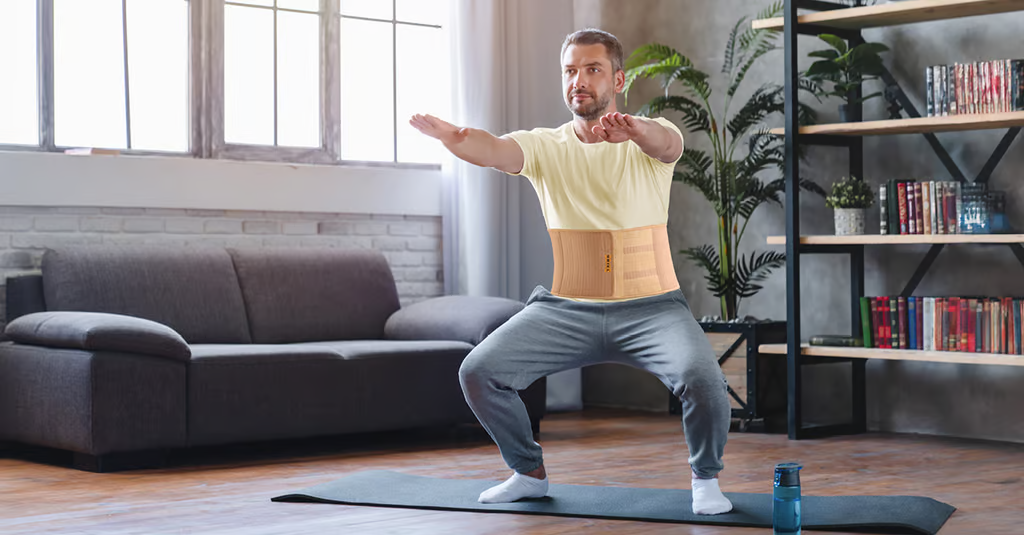
Treating Lower Back Pain: 6 Tips to Improve Quality of Life
Suffering from lower back pain? You are definitely not alone. There are many ways to deal with one of the most common pains in the world, here are some of them. It's time to relieve the pain.
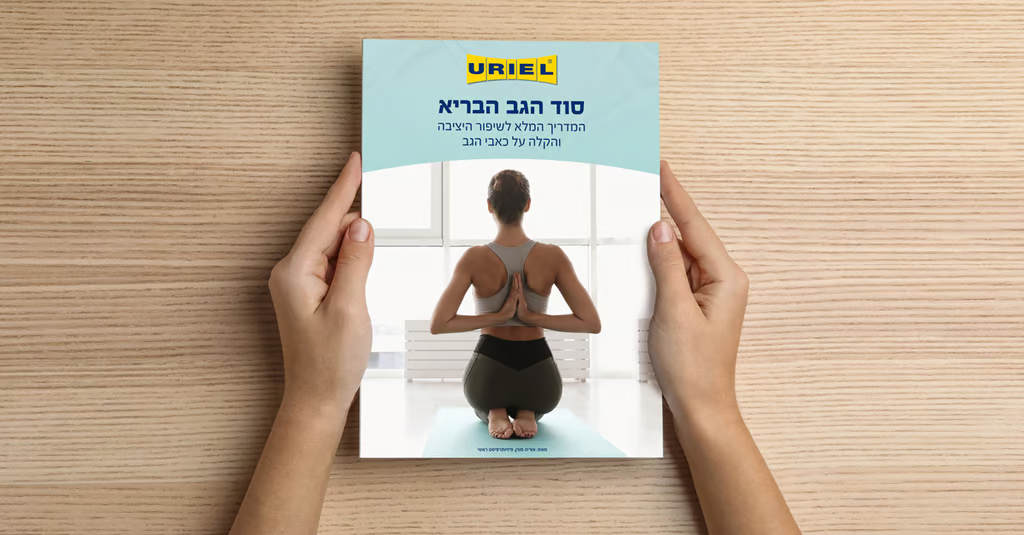
The Secret to a Healthy Back: The Complete Guide to Improving Posture and Alleviating Back Pain
Is back health important to you? Get the 'Secret of a Healthy Back' guide containing information, tips and useful advice for relieving back pain. By Oriya Moran, Chief Physiotherapist Download t...

Kinesio tape or professional elastic bandage?
Suffering from sports injuries, bruises or simply pain caused by medical problems? Get to know the variety of dressing products that will support you. When should we use kinesiology tape and why d...
